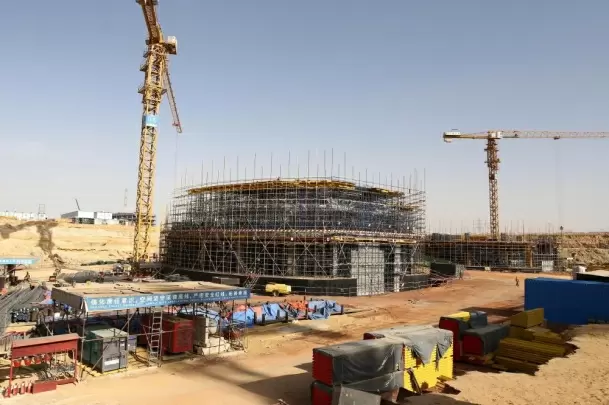China's lending fatigue in Africa opens doors for India and Japan
Atul Aneja
| New Delhi
14-December-2020

China's visible lender's fatigue is opening new opportunities for India and Japan to step up their game in Africa.
There are several reasons explaining China's growing financial crunch, leading to an anticipated drop in its lending in Africa, which is part of Beijing's Belt and Road Initiative (BRI)—a giant connectivity initiative, that meant to serve as an engine to propel China's global rise.
First, China's economy is slowing down. From growth rates of 7 per cent since 2010, China's growth rate is expected to drop significantly-in the range of 3.8 per cent and 4.9 per cent in the coming decade. There may simply not be enough cash in its kitty to invest in Africa, compared to current levels.
China is heavily indebted and has to repay hefty loans to G-20 countries, reducing its lending capacity to Africa. The country's share of overall debt owed to G20 countries increased from 45 per cent in 2013 to 63 per cent at the end of 2019.
"Lending by the Chinese financial institutions that drive the Belt and Road, along with bilateral support to governments, has fallen off a cliff, and Beijing finds itself mired in debt renegotiations with a host of countries," writes the Finacial Times in a recent article.
Second, there has been a radical shift in China's economic model. From an export driven economy, extensively relying on external resources and markets, China under its current leader Xi Jinping, is more inclined to tap domestic resources and markets as part of a more inward looking "double-circulation" economy. The adoption of the new model will have its implications on China's geo-economic engagement with Africa.
Watch This TWL Video
African countries that are likely to suffer most from China's lending curbs are Ethiopia, Ghana and Zambia, which are heavily dependent on Chinese debt.
The report estimates that because of China's more cautious lending approach, South Africa would be deprived by US $10.7 billion, Kenya of US $6.6 billion, Angola of US $5.2 billion, Ethiopia of US $4.7 billion, Egypt of US $1.3 billion, Zambia of US $1.1 billion and Ghana of US $0.9 billion, between 2021-25.
Over five years, these seven countries would lose a total of US $30.5 billion. This shortfall would be especially problematic for Ethiopia since close to 15 per cent of its external financing needs would be left uncovered.
China's economic slowdown could also mean a reduction in the demand for African raw materials, including iron ore, oil and gas. Raw material exporting countries such as Angola alone would lose US $4.7 billion as revenues. Overall, Africa will witness a US $9 billion decline in revenues over a 10-year period.
Over the past twenty years, China extended over US $150 billion of loans, but now, most countries are struggling to repay their debts, and Chinese creditors are becoming cautious about providing new loans to borrowers facing considerable financial duress.
The development marks a dramatic change when Beijing emerged as a key source of finance leaving behind the US and leading institutions like the World Bank and IMF. According to the New York-based consultancy Rhodium Group, at least 18 countries are currently renegotiating debts with China, with 12 others still in talks to restructure an estimated US $28billion of Chinese loans.
China's visible lender's fatigue opens the door for India and Japan to accelerate their financial and geo-economic presence in Africa.
But, in order to avail the looming opportunity, especially after the onset of Covid-19 pandemic, the two strategic partners in the Indo-Pacific will have to energetically front-end the Asia-Africa Growth Corridor (AAGC).
"The global spread of the Coronavirus pandemic has significantly augmented the trajectory of China's BRI (Belt and Road Initiative), particularly in Africa where projects have either been on hold or have been receiving minimal work. With the BRI on a downward curve in the continent, India and Japan can maximize the potential and operationalization of the AAGC to serve as an alternative for African states and possibly become a counter-weight to the monopolistic grasp of the BRI, says an article published by the Nepal Institute of International Cooperation and Engagement (NIICE).
Though conceptualised towards the end of 2016, the AAGC requires a high- octane boost. Its four major thrust areas in Africa—development projects, quality infrastructure and institutional connectivity, skill development and capacity building, and people-to-people cooperation, exist only on paper.
But with China overstretched, New Delhi and Tokyo have another opportunity push forward the AAGC initiative. Such a step will yield multiple benefits. For starters, it will help stall China's hegemonic inroads, based on "check book diplomacy" in the Global South, especially Africa. Ideologically, it will lower the appeal of the Chinese model of development, and showcase that democracies when working in sync can generate superior economic efficiency without compromising openness and transparency. Finally, the AAGC will provide a perfect opportunity to amplify and fuse India's extended neighbourhood doctrine with Japan's free and open Indo-Pacific strategy, serving as a template for replication in third countries.
From an African perspective, the AAGC will effortlessly dock with African plan for the transformation of the continent in the next 50 years under the Agenda 2063. - IANS
More Headlines
Bajrang Dal Appeals to Ban Oyo Check-Ins for Unmarried Couples in Bengaluru
Heavy Rains Predicted In Five TN Districts On January 11
Cold Wave Grips Rajasthan: Fatehpur Hits 1.1°C, Nagaur 1.7°C
Actor Ajith Kumar Escapes Unharmed After Crash During 24H Dubai Practice
32 Dead As 7.1 Magnitude Earthquake Strikes Nepal-Tibet Border
Bajrang Dal Appeals to Ban Oyo Check-Ins for Unmarried Couples in Bengaluru
Heavy Rains Predicted In Five TN Districts On January 11
Cold Wave Grips Rajasthan: Fatehpur Hits 1.1°C, Nagaur 1.7°C
Actor Ajith Kumar Escapes Unharmed After Crash During 24H Dubai Practice
32 Dead As 7.1 Magnitude Earthquake Strikes Nepal-Tibet Border










